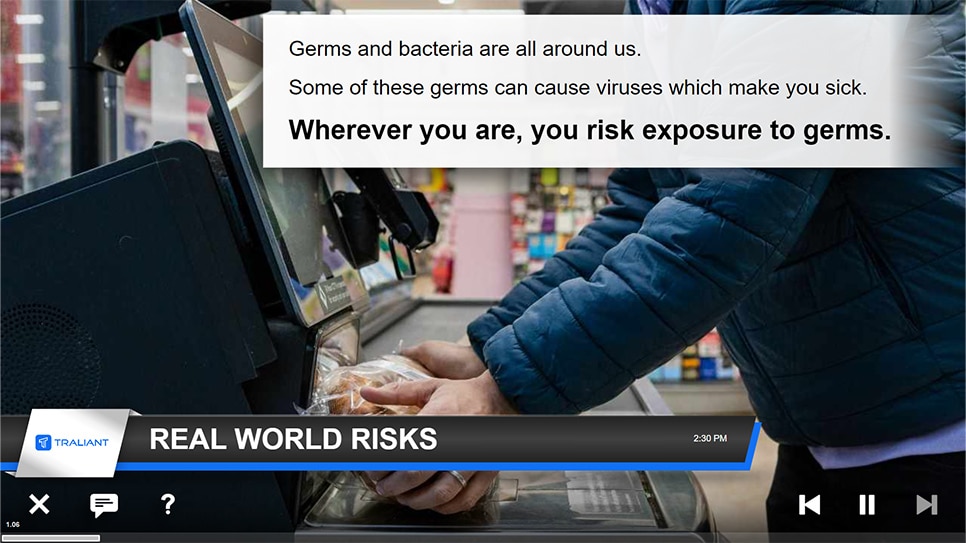
Infectious Disease Control
Understanding infectious disease control procedures and strategies can curb the transmission of infectious diseases in the workplace.
Course description
Traliant’s Infectious Disease Control training is a 20-minute course designed to provide learners with a fundamental understanding of infectious disease control measures. In this course, learners will understand key principles and strategies to prevent the spread of infectious diseases in various settings.
This course aligns with the Occupational Safety and Health Administration’s (OSHA) general industry programs and focuses on sources of infectious agent exposure and appropriate precautions for preventing infections.
ONLINE TRAINING
Infectious Disease Control

This course covers these topics and more:
- Types of infectious and communicable diseases
- How infectious diseases are spread
- Infection control basics
- Infection prevention principles
- Sharps safety and safe injection practices
- Strategies for staying safe
- OSHA standards and directives
KEY FEATURES
Why you'll love our training
It’s time to embrace a new era of online training with a valued partner who will ensure seamless implementation, along with a learning experience your employees will truly enjoy.
Course administration
Traliant makes it simple to roll out training to your workplace and provide technical support directly to your employees at no additional cost.
Course customizations
Tailor courses to include your logo, relevant policies, workplace images, and more. Traliant can even customize the course with scenarios that take place in your own workplace environment.
Translations
Training is available in English, Spanish and is supported in over 100 languages.
What to consider when choosing the most effective infectious disease control safety training

- Protect employee health and safety: Infectious diseases can be serious and even life-threatening. Training helps to ensure that employees understand the risks and know how to protect themselves and others.
- Comply with OSHA regulations: The Occupational Safety and Health Administration (OSHA) has regulations regarding infectious disease control in the workplace. Training helps organizations meet these legal requirements and to avoid costly fines and penalties.
- Reduce the risk of workplace outbreaks: Infectious diseases can spread rapidly in the workplace. Training can help to minimize the risk of outbreaks by teaching employees how to prevent the spread of disease.
- Empower employees: Training provides employees with the knowledge and skills they need to make informed decisions about their safety when working with infectious agents.
- Strengthen your organization's commitment to safety: Training demonstrates the company's commitment to providing a safe and healthy working environment and to protecting the health of its employees.
- Reduce the risk of accidents and injuries: When employees are aware of the risks and know how to work safely with infectious agents, they are less likely to be exposed to disease.
- Infectious agent: A pathogen, such as a virus, bacteria, or fungus, that can cause disease.
- Reservoir: A place where an infectious agent lives and multiplies, such as a person, animal, or object.
- Mode of transmission: The way in which an infectious agent is spread from one person or object to another, such as:
- Contact transmission: Direct contact with an infected person or object, or indirect contact with a contaminated object.
- Droplet transmission: The spread of infectious droplets through the air, usually through coughing or sneezing.
- Airborne transmission: The spread of infectious particles through the air, such as from dust or aerosols.
- Susceptible host: A person or animal that can be infected with an infectious agent.
- Influenza (the flu): A respiratory illness caused by a virus.
- COVID-19: A respiratory illness caused by a virus.
- Hepatitis B: A liver infection caused by a virus.
- Hepatitis C: A liver infection caused by a virus.
- Tuberculosis (TB): A lung infection caused by bacteria.
- Measles: A highly contagious viral illness.
- Mumps: A viral illness that can cause swelling of the salivary glands.
- Rubella (German measles): A viral illness that can cause a rash and joint pain.
- Hand hygiene: Wash your hands frequently with soap and water or use an alcohol-based hand sanitizer.
- Use personal protective equipment (PPE): Wear appropriate PPE, such as gloves, gowns, masks, and eye protection, when there is a risk of exposure to infectious agents.
- Clean and disinfect surfaces: Regularly clean and disinfect surfaces that may be contaminated with infectious agents.
- Isolate infected individuals: If an employee is suspected of having an infectious disease, they should be isolated from other employees.
- Follow safe injection practices: Use sterile needles and syringes and dispose of them properly.
- Practice sharps safety: Use caution when handling sharps, such as needles and syringes. Use sharps containers for disposal.
- Stay up-to-date on current recommendations: Follow the most current guidance from public health authorities, such as the Centers for Disease Control and Prevention (CDC).
- Follow your organization's infection control policies: Be aware of and adhere to your organization's policies and procedures related to infection control.
- Report any suspected cases of infectious disease: If you suspect that an employee has an infectious disease, report it to your supervisor.
- Educate yourself: Continue to learn about infection control and how to protect yourself and others from infectious diseases.










